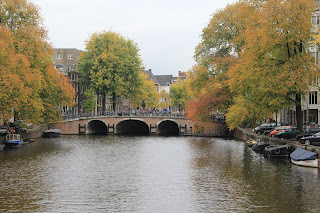We have been very busy in Amsterdam! On Thursday, October 18th, we woke up to rainy weather, but luckily, we had planned on a day indoors. We woke up early and headed to the Hermitage Museum, hoping to beat the crowds. The Hermitage is actually a Russian art museum that has satellite museums, like the one in Amsterdam. They rotate their collections, and while we were in Amsterdam, there was an impressionist exhibit. It followed the artwork leading up to Impressionism and then showed many great paintings throughout the Impressionist period. We had seen quite a few paintings from this genre, but it was still an impressive collection. The other half of the museum was a portion of paintings from the Van Gogh museum, which is here in Amsterdam. It is currently undergoing some renovations, so it is closed. We've seen a few Van Gogh's on this trip, but this was a collection of about 75 paintings, including the famous yellow sunflowers. We got to learn a bit more about Van Gogh's troubled life, mental illness (probably schizophrenia), and gain some insight into his inspirations via letters to his brother. It was a great museum and definitely worth the early morning!
It was still raining after the Hermitage Museum, so we headed to the Rjyksmuseum to stay dry. This museum is also artwork; however, it features Dutch paintings, sculptures and a few old artifacts. The most famous Dutch painter, Rembrandt, has several paintings in this museum, and they were fantastic. His use of light and his ability to paint detail and metallics are what made him so famous. We moved pretty quickly through this museum and focused on the highlights.
There was a break in the weather at this point in the day, so we decided to take advantage and have some lunch. We grabbed a couple of hamburgers which were actually more like a sausage patty. It was one of the few foods in Amsterdam that we didn't really care for. A couple stands down from the hamburgers, we found what I have been looking forward to and searching for since we arrived in Amsterdam--stroopwafels!! This is The Netherlands version of a waffle, but it is much different than the Belgian waffles that we all know. It is very thin, probably a quarter of an inch, and crispy. It is made on a waffle iron, cut in half (so you have two full circles), and then a delicious and thick caramel sauce is spread on the waffle before putting it back together. The result is a crispy cookie-like waffle filled with caramel. I had a packaged version of this waffle during a flight from Amsterdam last summer, and I knew that I needed the real thing. I was not left disappointed, and we will definitely be on the lookout for more stroopwafels during our stay in Amsterdam.
With full bellies, we were ready for the afternoon's activities. We had already had our art education that morning, so now it was time for the alcohol! We headed to the Bols Experience, which would be our first stop on this alcohol adventure. The Bols company makes genever, which is a Dutch gin, and thirty-six different liqueurs. We started the self-guided tour with low expectations, but we were pleasantly surprised. The tour walks you through different interactive stations that allow you to better understand how the senses work together and how each of your senses can affect the way you taste something.
We started with small flavor strips that we placed on our tongue while watching a video that was supposed to confuse your mind as to what flavor we were tasting. Then, we placed a different strip on our tongue while plugging our nose. Neither of us could discern the taste until we unplugged our nose, and then it was a very obvious mint flavor. I've seen experiments like this done before, but it was a fun way to start the tour.
We got to touch a few of the different spices and herbs used in the genever and liqueurs before moving onto another smelling portion of the tour. They had small bottles set up with each of the thirty-six different liqueur scents. We were supposed to go through and smell each one and guess what it was. Some were very easy to tell, some we had no idea, and others were familiar scents that we just couldn't quite figure out.
We moved through the rest of the tour quickly, as the hearing and seeing rooms were just advertisements for Bols. I suppose they have to get their plug in at some point! We didn't really mind because the best part of the tour was about to begin. We moved into the bar area, but first had to stop at a computer. We looked through different cocktails, and then printed off one that we wanted to try. Our bartender Marvin was phenomenal. I tried a Mai Tai and Jeremy tried a Gold Fashioned (similar to an Old Fashioned). They were both delicious (and strong), but my favorite part was watching the bartenders make the cocktails. Marvin showed us how to mix the cocktail in shaker, how to make a fireball from an orange peel, and he answered all of our questions.
After the cocktail, we also got to taste two of the liqueurs or genevers. We figured that it would be a tiny taste, but it was actually full shots of each. I decided to be adventurous and try a genever, so Marvin started me out with the easiest sipping, unaged genever. It was actually more like a very smooth, almost tasteless vodka rather than a gin. There are fewer juniper berries in Dutch genever, so you don't get the strong pine needle taste like in other gins. I also tried the coffee liqueur, which was fantastic on its own. Jeremy decided to try the barrel-aged genever, which he said was more like a light whiskey than gin. Because we had developed a relationship with our bartender, Marvin gave Jeremy an off menu genever for his second shot. It was a six year aged genever, which was also similar to a whiskey and apparently very delicious.
We had the option of buying a second cocktail for just five euro, which is a fantastic deal for a really well-made cocktail, so Jeremy decided that it was too good to pass up. I decided not to get another cocktail, but Marvin decided that Jeremy couldn't drink alone so he offered me a non-alcoholic drink. I accepted, thinking that a glass of water would taste good. I was surprised when he started pulling out all sorts of things for my drink. He put raspberries, some kind of lettuce leaf, two slices of hot pepper, a bit of egg white (to bind), grapefruit juice and a few other things into a shaker. He mashed it up a bit and then gave it a good shake before pouring it into a chilled glass. It was actually very good. The flavors were extremely complex, and you could taste each component of the drink. It worked surprisingly well, and I could understand what Marvin meant when he told us that he is a "chef of liquids."
We reluctantly left the Bols Experience after three hours of learning, drinking, and fun; however our alcohol education was not finished! We walked just a few blocks to the Heineken brewery. It was, as expected, an advertisement for the company; although, it was still a good time complete with a tasting. The highlight of the tour was a ten minute video that followed the process of a piece of grain turning into Heineken beer. During the video, we stood on platforms that shook, rocked, and turned with the video. We got splashed on when the grain jumped into the vat of liquid, and we could smell the various odors during the process, and we could feel the heat when the brew was boiling. It was a cute video, and we learned a few things about beer making that we hadn't heard before. It was interesting to do the brewery tour of a huge company versus the smaller breweries that we typically do.
The Heineken tour included a 15 minute boat ride through the canals from the brewery to a different Heineken shop. The shop was on the way back to our neighborhood, so we took advantage of the free boat ride. We stumbled back to our apartment after a day packed with learning. The next two days would be busy with day trips, so we needed to get some rest (and water)!
The Heineken tour included a 15 minute boat ride through the canals from the brewery to a different Heineken shop. The shop was on the way back to our neighborhood, so we took advantage of the free boat ride. We stumbled back to our apartment after a day packed with learning. The next two days would be busy with day trips, so we needed to get some rest (and water)!























































